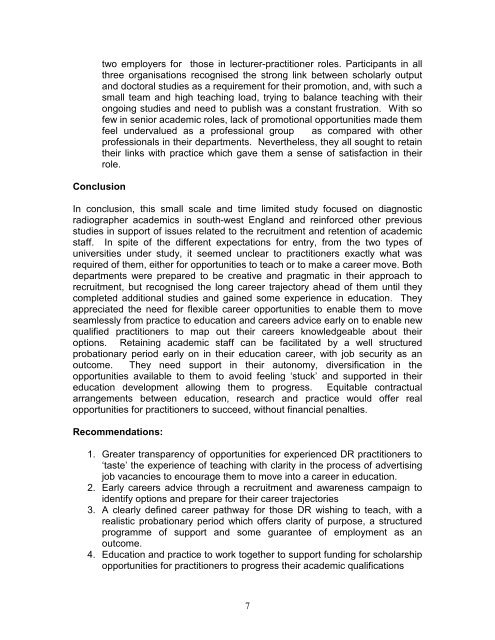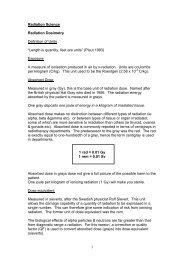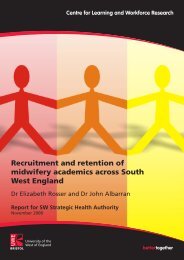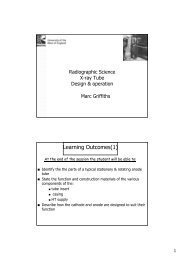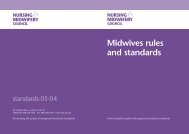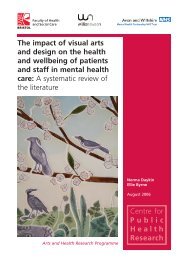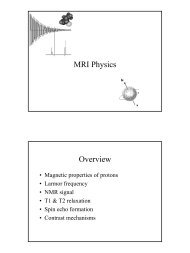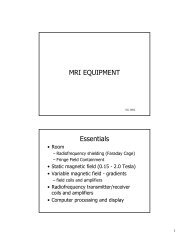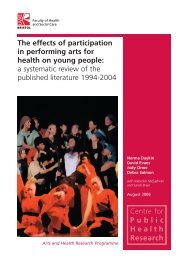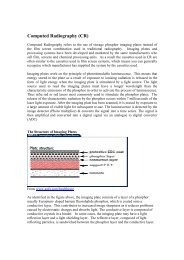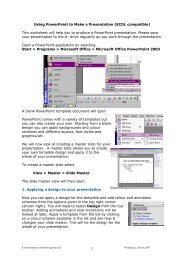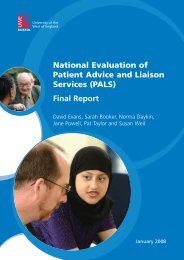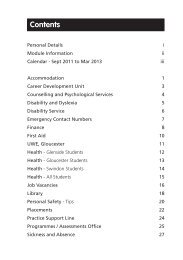Recruitment and retention of diagnostic radiography academics ...
Recruitment and retention of diagnostic radiography academics ...
Recruitment and retention of diagnostic radiography academics ...
- No tags were found...
Create successful ePaper yourself
Turn your PDF publications into a flip-book with our unique Google optimized e-Paper software.
two employers for those in lecturer-practitioner roles. Participants in allthree organisations recognised the strong link between scholarly output<strong>and</strong> doctoral studies as a requirement for their promotion, <strong>and</strong>, with such asmall team <strong>and</strong> high teaching load, trying to balance teaching with theirongoing studies <strong>and</strong> need to publish was a constant frustration. With s<strong>of</strong>ew in senior academic roles, lack <strong>of</strong> promotional opportunities made themfeel undervalued as a pr<strong>of</strong>essional group as compared with otherpr<strong>of</strong>essionals in their departments. Nevertheless, they all sought to retaintheir links with practice which gave them a sense <strong>of</strong> satisfaction in theirrole.ConclusionIn conclusion, this small scale <strong>and</strong> time limited study focused on <strong>diagnostic</strong>radiographer <strong>academics</strong> in south-west Engl<strong>and</strong> <strong>and</strong> reinforced other previousstudies in support <strong>of</strong> issues related to the recruitment <strong>and</strong> <strong>retention</strong> <strong>of</strong> <strong>academics</strong>taff. In spite <strong>of</strong> the different expectations for entry, from the two types <strong>of</strong>universities under study, it seemed unclear to practitioners exactly what wasrequired <strong>of</strong> them, either for opportunities to teach or to make a career move. Bothdepartments were prepared to be creative <strong>and</strong> pragmatic in their approach torecruitment, but recognised the long career trajectory ahead <strong>of</strong> them until theycompleted additional studies <strong>and</strong> gained some experience in education. Theyappreciated the need for flexible career opportunities to enable them to moveseamlessly from practice to education <strong>and</strong> careers advice early on to enable newqualified practitioners to map out their careers knowledgeable about theiroptions. Retaining academic staff can be facilitated by a well structuredprobationary period early on in their education career, with job security as anoutcome. They need support in their autonomy, diversification in theopportunities available to them to avoid feeling ‘stuck’ <strong>and</strong> supported in theireducation development allowing them to progress. Equitable contractualarrangements between education, research <strong>and</strong> practice would <strong>of</strong>fer realopportunities for practitioners to succeed, without financial penalties.Recommendations:1. Greater transparency <strong>of</strong> opportunities for experienced DR practitioners to‘taste’ the experience <strong>of</strong> teaching with clarity in the process <strong>of</strong> advertisingjob vacancies to encourage them to move into a career in education.2. Early careers advice through a recruitment <strong>and</strong> awareness campaign toidentify options <strong>and</strong> prepare for their career trajectories3. A clearly defined career pathway for those DR wishing to teach, with arealistic probationary period which <strong>of</strong>fers clarity <strong>of</strong> purpose, a structuredprogramme <strong>of</strong> support <strong>and</strong> some guarantee <strong>of</strong> employment as anoutcome.4. Education <strong>and</strong> practice to work together to support funding for scholarshipopportunities for practitioners to progress their academic qualifications7


